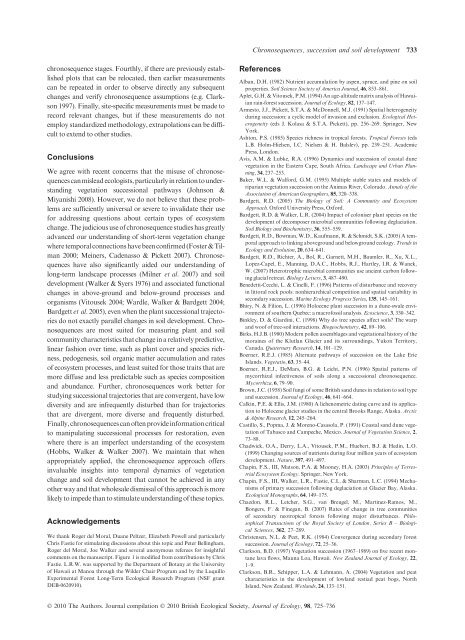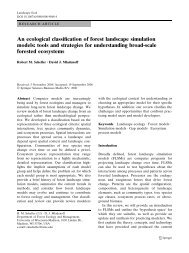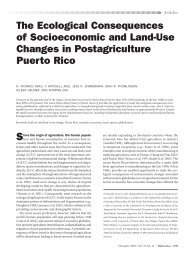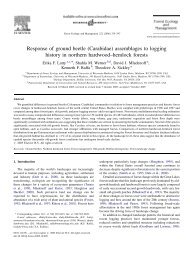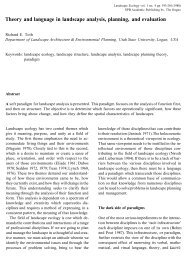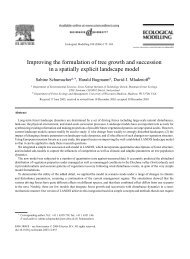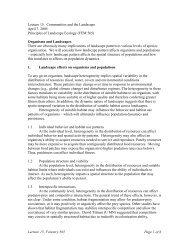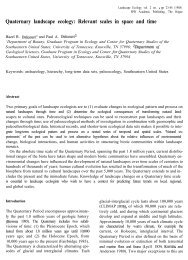The use of chronosequences in studies of ecological succession ...
The use of chronosequences in studies of ecological succession ...
The use of chronosequences in studies of ecological succession ...
You also want an ePaper? Increase the reach of your titles
YUMPU automatically turns print PDFs into web optimized ePapers that Google loves.
Chronosequences, <strong>succession</strong> and soil development 733chronosequence stages. Fourthly, if there are previously establishedplots that can be relocated, then earlier measurementscan be repeated <strong>in</strong> order to observe directly any subsequentchanges and verify chronosequence assumptions (e.g. Clarkson1997). F<strong>in</strong>ally, site-specific measurements must be made torecord relevant changes, but if these measurements do notemploy standardized methodology, extrapolations can be difficultto extend to other <strong>studies</strong>.ConclusionsWe agree with recent concerns that the mis<strong>use</strong> <strong>of</strong> <strong>chronosequences</strong>can mislead ecologists, particularly <strong>in</strong> relation to understand<strong>in</strong>gvegetation <strong>succession</strong>al pathways (Johnson &Miyanishi 2008). However, we do not believe that these problemsare sufficiently universal or severe to <strong>in</strong>validate their <strong>use</strong>for address<strong>in</strong>g questions about certa<strong>in</strong> types <strong>of</strong> ecosystemchange. <strong>The</strong> judicious <strong>use</strong> <strong>of</strong> chronosequence <strong>studies</strong> has greatlyadvanced our understand<strong>in</strong>g <strong>of</strong> short-term vegetation changewhere temporal connections have been confirmed (Foster & Tilman2000; Me<strong>in</strong>ers, Cadenasso & Pickett 2007). Chronosequenceshave also significantly aided our understand<strong>in</strong>g <strong>of</strong>long-term landscape processes (Milner et al. 2007) and soildevelopment (Walker & Syers 1976) and associated functionalchanges <strong>in</strong> above-ground and below-ground processes andorganisms (Vito<strong>use</strong>k 2004; Wardle, Walker & Bardgett 2004;Bardgett et al. 2005), even when the plant <strong>succession</strong>al trajectoriesdo not exactly parallel changes <strong>in</strong> soil development. Chronosequencesare most suited for measur<strong>in</strong>g plant and soilcommunity characteristics that change <strong>in</strong> a relatively predictive,l<strong>in</strong>ear fashion over time, such as plant cover and species richness,pedogenesis, soil organic matter accumulation and rates<strong>of</strong> ecosystem processes, and least suited for those traits that aremore diff<strong>use</strong> and less predictable such as species compositionand abundance. Further, <strong>chronosequences</strong> work better forstudy<strong>in</strong>g <strong>succession</strong>al trajectories that are convergent, have lowdiversity and are <strong>in</strong>frequently disturbed than for trajectoriesthat are divergent, more diverse and frequently disturbed.F<strong>in</strong>ally, <strong>chronosequences</strong> can <strong>of</strong>ten provide <strong>in</strong>formation criticalto manipulat<strong>in</strong>g <strong>succession</strong>al processes for restoration, evenwhere there is an imperfect understand<strong>in</strong>g <strong>of</strong> the ecosystem(Hobbs, Walker & Walker 2007). We ma<strong>in</strong>ta<strong>in</strong> that whenappropriately applied, the chronosequence approach <strong>of</strong>fers<strong>in</strong>valuable <strong>in</strong>sights <strong>in</strong>to temporal dynamics <strong>of</strong> vegetationchange and soil development that cannot be achieved <strong>in</strong> anyother way and that wholesale dismissal <strong>of</strong> this approach is morelikely to impede than to stimulate understand<strong>in</strong>g <strong>of</strong> these topics.AcknowledgementsWe thank Roger del Moral, Duane Peltzer, Elizabeth Powell and particularlyChris Fastie for stimulat<strong>in</strong>g discussions about this topic and Peter Bell<strong>in</strong>gham,Roger del Moral, Joe Walker and several anonymous referees for <strong>in</strong>sightfulcomments on the manuscript. Figure 1 is modified from contributions by ChrisFastie. L.R.W. was supported by the Department <strong>of</strong> Botany at the University<strong>of</strong> Hawaii at Manoa through the Wilder Chair Program and by the LuquilloExperimental Forest Long-Term Ecological Research Program (NSF grantDEB-0620910).ReferencesAlban, D.H. (1982) Nutrient accumulation by aspen, spruce, and p<strong>in</strong>e on soilproperties. Soil Science Society <strong>of</strong> America Journal, 46, 853–861.Aplet, G.H. & Vito<strong>use</strong>k, P.M. (1994) An age-altitude matrix analysis <strong>of</strong> Hawaiianra<strong>in</strong>-forest <strong>succession</strong>. Journal <strong>of</strong> Ecology, 82, 137–147.Armesto, J.J., Pickett, S.T.A. & McDonnell, M.J. (1991) Spatial heterogeneitydur<strong>in</strong>g <strong>succession</strong>: a cyclic model <strong>of</strong> <strong>in</strong>vasion and exclusion. Ecological Heterogeneity(eds J. Kolasa & S.T.A. Pickett), pp. 256–269. Spr<strong>in</strong>ger, NewYork.Ashton, P.S. (1985) Species richness <strong>in</strong> tropical forests. Tropical Forests (edsL.B. Holm-Hielsen, I.C. Nielsen & H. Balslev), pp. 239–251. AcademicPress, London.Avis, A.M. & Lubke, R.A. (1996) Dynamics and <strong>succession</strong> <strong>of</strong> coastal dunevegetation <strong>in</strong> the Eastern Cape, South Africa. Landscape and Urban Plann<strong>in</strong>g,34, 237–253.Baker, W.L. & Walford, G.M. (1995) Multiple stable states and models <strong>of</strong>riparian vegetation <strong>succession</strong> on the Animas River, Colorado. Annals <strong>of</strong> theAssociation <strong>of</strong> American Geographers, 85, 320–338.Bardgett, R.D. (2005) <strong>The</strong> Biology <strong>of</strong> Soil: A Community and EcosystemApproach. Oxford University Press, Oxford.Bardgett, R.D. & Walker, L.R. (2004) Impact <strong>of</strong> coloniser plant species on thedevelopment <strong>of</strong> decomposer microbial communities follow<strong>in</strong>g deglaciation.Soil Biology and Biochemistry, 36, 555–559.Bardgett, R.D., Bowman, W.D., Kaufmann, R. & Schmidt, S.K. (2005) A temporalapproach to l<strong>in</strong>k<strong>in</strong>g aboveground and belowground ecology. Trends <strong>in</strong>Ecology and Evolution, 20, 634–641.Bardgett, R.D., Richter, A., Bol, R., Garnett, M.H., Baumler, R., Xu, X.L.,Lopez-Capel, E., Mann<strong>in</strong>g, D.A.C., Hobbs, R.J., Hartley, I.R. & Wanek,W. (2007) Heterotrophic microbial communities <strong>use</strong> ancient carbon follow<strong>in</strong>gglacial retreat. Biology Letters, 3, 487–490.Benedetti-Cecchi, L. & C<strong>in</strong>elli, F. (1996) Patterns <strong>of</strong> disturbance and recovery<strong>in</strong> littoral rock pools: nonhierarchical competition and spatial variability <strong>in</strong>secondary <strong>succession</strong>. Mar<strong>in</strong>e Ecology Progress Series, 135, 145–161.Bhiry, N. & Filion, L. (1996) Holocene plant <strong>succession</strong> <strong>in</strong> a dune-swale environment<strong>of</strong> southern Quebec: a macr<strong>of</strong>ossil analysis. Ecoscience, 3, 330–342.B<strong>in</strong>kley, D. & Giard<strong>in</strong>i, C. (1998) Why do tree species affect soils? <strong>The</strong> warpand wo<strong>of</strong> <strong>of</strong> tree-soil <strong>in</strong>teractions. Biogeochemistry, 42, 89–106.Birks, H.J.B. (1980) Modern pollen assemblages and vegetational history <strong>of</strong> themora<strong>in</strong>es <strong>of</strong> the Klutlan Glacier and its surround<strong>in</strong>gs, Yukon Territory,Canada. Quaternary Research, 14, 101–129.Boerner, R.E.J. (1985) Alternate pathways <strong>of</strong> <strong>succession</strong> on the Lake ErieIslands. Vegetatio, 63, 35–44.Boerner, R.E.J., DeMars, B.G. & Leicht, P.N. (1996) Spatial patterns <strong>of</strong>mycorrhizal <strong>in</strong>fectiveness <strong>of</strong> soils along a <strong>succession</strong>al chronosequence.Mycorrhiza, 6,79–90.Brown, J.C. (1958) Soil fungi <strong>of</strong> some British sand dunes <strong>in</strong> relation to soil typeand <strong>succession</strong>. Journal <strong>of</strong> Ecology, 46, 641–664.Calk<strong>in</strong>, P.E. & Ellis, J.M. (1980) A lichenometric dat<strong>in</strong>g curve and its applicationto Holocene glacier <strong>studies</strong> <strong>in</strong> the central Brooks Range, Alaska. Arctic& Alp<strong>in</strong>e Research, 12, 245–264.Castillo, S., Popma, J. & Moreno-Casasola, P. (1991) Coastal sand dune vegetation<strong>of</strong> Tabasco and Campeche, Mexico. Journal <strong>of</strong> Vegetation Science, 2,73–88.Chadwick, O.A., Derry, L.A., Vito<strong>use</strong>k, P.M., Huebert, B.J. & Hed<strong>in</strong>, L.O.(1999) Chang<strong>in</strong>g sources <strong>of</strong> nutrients dur<strong>in</strong>g four million years <strong>of</strong> ecosystemdevelopment. Nature, 397, 491–497.Chap<strong>in</strong>, F.S., III, Matson, P.A. & Mooney, H.A. (2003) Pr<strong>in</strong>ciples <strong>of</strong> TerrestrialEcosystem Ecology. Spr<strong>in</strong>ger, New York.Chap<strong>in</strong>, F.S., III, Walker, L.R., Fastie, C.L. & Sharman, L.C. (1994) Mechanisms<strong>of</strong> primary <strong>succession</strong> follow<strong>in</strong>g deglaciation at Glacier Bay, Alaska.Ecological Monographs, 64, 149–175.Chazdon, R.L., Letcher, S.G., van Breugel, M., Mart<strong>in</strong>ez-Ramos, M.,Bongers, F. & F<strong>in</strong>egan, B. (2007) Rates <strong>of</strong> change <strong>in</strong> tree communities<strong>of</strong> secondary neotropical forests follow<strong>in</strong>g major disturbances. PhilosophicalTransactions <strong>of</strong> the Royal Society <strong>of</strong> London, Series B – BiologicalSciences, 362, 27–289.Christensen, N.L. & Peet, R.K. (1984) Convergence dur<strong>in</strong>g secondary forest<strong>succession</strong>. Journal <strong>of</strong> Ecology, 72, 25–36.Clarkson, B.D. (1997) Vegetation <strong>succession</strong> (1967–1989) on five recent montanelava flows, Mauna Loa, Hawaii. New Zealand Journal <strong>of</strong> Ecology, 22,1–9.Clarkson, B.R., Schipper, L.A. & Lehmann, A. (2004) Vegetation and peatcharacteristics <strong>in</strong> the development <strong>of</strong> lowland restiad peat bogs, NorthIsland, New Zealand. Wetlands, 24, 133–151.Ó 2010 <strong>The</strong> Authors. Journal compilation Ó 2010 British Ecological Society, Journal <strong>of</strong> Ecology, 98, 725–736


